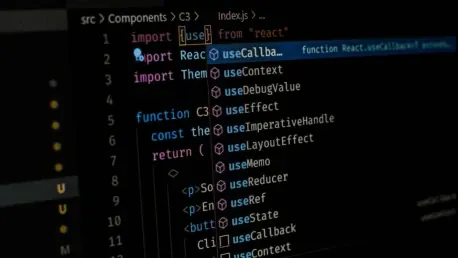The competition between Java and Python in the realm of artificial intelligence (AI) and machine learning (ML) has intensified, prompting many to reconsider Java’s potential. Despite Python’s overwhelming dominance in these fields, Java continues to wield its long-standing advantages and extensive ecosystem to carve a niche for itself. Java’s reliability, solid performance, and historical strengths significantly contribute to its evolving role in AI and ML integration. This article delves into various Java-based tools and frameworks that underscore its viability in the AI and ML space.
Java’s Legacy in AI and Machine Learning
Java’s intrinsic strengths, such as well-defined data types, robust performance, and the efficient Java Virtual Machine (JVM), make it a solid contender in the AI and ML domains. While Python is often lauded for its simplicity and extensive libraries, Java offers unparalleled stability and backward compatibility, thanks to continuous innovations overseen by Sun Microsystems and Oracle. This steadfast reliability attracts developers who prefer a more structured and scalable language.
Furthermore, Java’s extensive ecosystem, thriving with comprehensive libraries and frameworks, provides a strong foundation for diverse applications in AI and ML. These tools facilitate intricate data handling, efficient algorithm execution, and seamless integration of machine learning models, thus paving the way for sophisticated advancements.
Spring AI: A Strong Foundation
Simplifying Integration
Spring AI emerges as a groundbreaking framework that streamlines the integration of AI models into applications ranging from web services to microservices. By offering a robust set of abstractions, Spring AI simplifies complex processes, making it easier for developers to organize and define various AI tasks. This user-friendly integration is a key factor behind its growing popularity among Java developers.
In practice, Spring AI accommodates various AI models and functionalities, allowing developers to embed sophisticated AI processes without navigating the complexities of traditional integration methods. The framework’s modular design ensures that developers can effortlessly add, modify, or remove components, thus fostering a dynamic development environment. This capability is crucial for developers looking to build flexible, scalable AI-driven applications.
Compatibility and Storage
Support for major AI providers, including Anthropic and OpenAI, makes Spring AI a versatile platform for rapid model integration. It facilitates swift deployment of models designed for tasks such as chat completion and content moderation. Furthermore, the framework enhances data storage capabilities by working seamlessly with vector databases like Milvus and Pinecone, which are pivotal in managing large datasets effectively.
Spring AI offers features to store and manage chat conversations and evaluate AI models, further enhancing its utility in creating comprehensive AI solutions. These capabilities streamline the workflow for developers, enabling them to focus on refining AI models and improving their applications’ performance.
LangChain4j and Flexible AI Solutions
Versatile Model Integration
LangChain4j is designed to support the integration of multiple large language models (LLMs) and vector databases, creating a cohesive framework for a variety of AI projects. As an extension of the well-regarded LangChain framework, LangChain4j caters to Java developers by unifying diverse models and databases into comprehensive solutions. This versatility is advantageous for projects requiring complex interactions among different AI components.
The framework’s ability to unify multiple LLMs allows developers to leverage the strengths of each model, thus enhancing the overall functionality of their applications. LangChain4j’s design promotes efficient model management and smoother integration processes, leading to more robust and scalable AI solutions. The framework’s flexibility is particularly valuable for projects that demand extensive customization and detailed attention to model integration.
Unified Abstractions
As a Java-first extension, LangChain4j stands out by unifying various models and data stores into standard abstractions. This approach facilitates smoother integration and utilization, making it easier for developers to manage complex AI workflows. The framework’s standardization simplifies the development process, enabling developers to focus on refining AI model performance rather than grappling with integration challenges.
LangChain4j’s comprehensive suite of tools ensures consistent and reliable performance across different applications. By combining distinct AI components into cohesive systems, LangChain4j helps developers create efficient, scalable AI solutions. This unification of models and data stores into standardized abstractions marks a significant advancement in developing AI applications using Java.
Deeplearning4J: Advanced AI Classification
Comprehensive Algorithm Support
Deeplearning4J (DL4J) is a prominent framework within the Eclipse ecosystem, specifically designed for Java developers working on AI classification tasks. This powerful tool supports an extensive range of machine learning algorithms, enabling developers to tackle various projects effectively. The framework’s foundation in libnd4j, a fast C++ library, ensures efficient execution of machine learning primitives, paving the way for high-performance AI applications.
DL4J’s versatility extends to its support for multiple languages within the JVM ecosystem, including Kotlin and Scala. This cross-language compatibility fosters a collaborative environment where developers can choose the most suitable language for their projects. Additionally, DL4J’s integration with Python via Python4j allows developers to harness Python’s rich set of libraries and functionalities directly within Java applications.
Accessible Open-Source Framework
The open-source nature of DL4J, combined with thorough documentation, makes it highly accessible to developers. Comprehensive documentation and community support empower developers to leverage DL4J’s full potential, facilitating effective utilization of its components. This accessibility ensures that developers can readily implement complex AI algorithms, thus accelerating the development cycle.
DL4J’s wide range of pre-built models and algorithms further simplifies the development process, allowing developers to focus on refining and optimizing their AI applications. The framework’s open-source community fosters innovation and collaboration, driving the continuous improvement and expansion of DL4J’s capabilities. This collaborative environment enhances the overall utility of DL4J in AI and ML projects.
Apache Spark MLib: Large-Scale Data Analysis
Efficient Algorithm Implementation
Apache Spark MLib offers a robust platform for machine learning within the larger context of Apache Spark’s data processing capabilities. The framework provides pre-built routines for classic machine learning algorithms, minimizing the need for extensive coding efforts. This streamlined approach to algorithm implementation allows developers to focus on analyzing and interpreting data, rather than dealing with low-level coding intricacies.
Spark MLib’s extensive suite of machine learning algorithms is designed to process large-scale datasets efficiently, making it a preferred choice for data-intensive applications. The framework’s integration with various JVM languages, including Java and Scala, further enhances its versatility and ease of use. This seamless integration allows developers to leverage the strengths of different languages within a single framework, optimizing the overall development process.
Distributed Computation
One of Spark’s most significant advantages is its ability to distribute computational tasks across multiple machines. This distributed computation capability is particularly advantageous for iterative processes that require substantial resources. By distributing heavy computations, Spark ensures that large-scale data analysis tasks are executed efficiently, leading to faster processing times and more accurate results.
Spark’s distributed nature also enhances the framework’s scalability, making it suitable for projects of varying sizes and complexities. This scalability ensures that developers can handle growing datasets and computational demands without compromising performance. The ability to distribute computation tasks effectively positions Spark MLib as a critical tool for large-scale AI and ML projects.
GraalPy: Bridging Java and Python
Optimized Python Integration
GraalPy, a component of the broader GraalVM project, bridges the gap between Java and Python by embedding Python within the JVM. This integration allows Java developers to utilize Python libraries and tools efficiently, thus combining the strengths of both languages in a single environment. GraalPy’s optimized execution speed ensures that Python scripts run seamlessly within Java applications, enhancing overall performance.
This bridge between Java and Python is especially valuable for projects that require the unique capabilities of Python, such as extensive data analysis and specialized machine learning libraries. By enabling direct access to Python functionalities, GraalPy opens new avenues for developers to enhance their AI and ML applications. This integration fosters a more collaborative and versatile development environment, optimizing resource utilization.
Enhanced Execution Speed
GraalPy’s optimized execution speed, a result of the broader GraalVM project, ensures that multi-language projects run efficiently. This optimization is crucial for projects that leverage the diverse capabilities of Python within Java applications. By enhancing execution speed, GraalPy minimizes latency and ensures smooth, responsive performance, making it easier for developers to manage complex workflows.
The performance enhancements offered by GraalPy significantly improve the efficiency of AI and ML applications, allowing developers to execute resource-intensive tasks with minimal delays. This optimization ensures that developers can build and deploy high-performance applications that leverage the strengths of both Java and Python. By enhancing execution speed, GraalPy reinforces its role as a vital tool for multi-language AI and ML projects.
Specialized Natural Language Processing
Apache OpenNLP
Apache OpenNLP is a dedicated framework for natural language processing (NLP) within Java-based applications. The framework addresses various text preprocessing needs in AI projects, offering algorithms for tasks such as tokenization, parsing, and language detection. These fundamental NLP tasks are essential for extracting meaningful information from textual data, making OpenNLP a valuable tool for AI projects.
OpenNLP’s strong multi-language support further enhances its utility, allowing developers to process text in multiple languages seamlessly. This multi-language capability is particularly valuable for global applications that require accurate text processing across different linguistic contexts. The framework’s robust algorithms ensure precise and reliable results, making it a preferred choice for text-driven AI and ML applications.
Stanford CoreNLP
Stanford CoreNLP offers a comprehensive suite of NLP tools, ranging from basic segmentation to more advanced tasks like sentiment analysis and coreference detection. Developed by the Stanford NLP Group, the framework is renowned for its high accuracy and pre-built models. These pre-built models simplify the development process, allowing developers to implement sophisticated NLP functionalities with minimal effort.
CoreNLP’s seamless integration with Java projects through tools like Maven or Gradle further enhances its utility. This easy integration allows developers to incorporate advanced NLP capabilities into their applications without extensive setup or configuration. The framework’s support for multiple languages ensures that developers can build global applications with robust NLP functionalities.
Handling Complex Data Relationships
Neo4j’s Graph Database
Neo4j stands out as a potent graph database, excelling in managing and querying complex data relationships. Particularly suitable for applications requiring sophisticated data interactions, such as fraud detection and social network management, Neo4j’s capabilities are indispensable. The database handles RAG data stores proficiently, enabling developers to create detailed and intricate data models.
Neo4j’s capacity to manage extensive datasets and complex relationships makes it a critical tool for AI-driven applications. By facilitating advanced querying and data interaction, Neo4j ensures that developers can build applications capable of handling intricate data structures. This proficiency is crucial for real-world applications that require detailed analysis and insights from complex datasets.
Integration and Performance
Neo4j’s GraphRAG feature integrates RAG applications with Java stacks seamlessly, enhancing performance and functionality. The database’s robust querying capabilities allow developers to execute complex queries efficiently, making it a valuable asset for AI applications that rely on detailed data relationships. Neo4j’s performance and integration capabilities ensure that developers can harness its full potential in their projects.
The database’s ability to handle complex data relationships and perform advanced queries positions Neo4j as a critical component in AI and ML applications. Its seamless integration with Java stacks ensures that developers can leverage its capabilities without encountering compatibility issues. This integration, coupled with Neo4j’s robust performance, underscores its importance in managing complex data relationships effectively.
Local AI Model Execution
Jllama Capabilities
Jllama facilitates the local execution of popular open-source large language models (LLMs) within a managed JVM environment. This capability ensures privacy, security, and cost-effectiveness by eliminating the need to rely on remote APIs. By running LLMs locally, developers can maintain greater control over their data and models, enhancing overall security and privacy.
The ability to execute models locally is particularly valuable for applications that handle sensitive data or require stringent compliance with privacy regulations. Jllama’s capabilities ensure that developers can build secure AI applications without compromising performance or functionality. This local execution not only enhances security but also reduces dependency on external APIs, leading to significant cost savings.
Optimization Features
Leveraging new Java features like the Vector API and SIMD-aware extensions, Jllama optimizes LLM inference and efficiently distributes the computational workload. These optimization features ensure that LLMs run smoothly within the JVM environment, delivering high performance and efficiency. The framework’s optimization capabilities are crucial for applications requiring rapid and accurate LLM inference.
Jllama’s efficient workload distribution minimizes processing delays and enhances overall performance, making it a reliable option for computationally intensive AI tasks. The framework’s ability to optimize and distribute computational workloads ensures that developers can build high-performance applications without encountering bottlenecks or performance issues. These optimization features reinforce Jllama’s role as a critical tool for local AI model execution.
Summary and Conclusion
The rivalry between Java and Python in the fields of artificial intelligence (AI) and machine learning (ML) has become more pronounced, leading many to rethink Java’s potential in these areas. While Python maintains a dominant presence due to its simplicity and extensive libraries, Java still has noteworthy advantages and a vast ecosystem that allow it to maintain a competitive edge. Java’s reputation for reliability, robust performance, and historical strengths plays a crucial role in its ongoing integration into AI and ML projects.
Java’s long-standing presence has allowed it to develop a variety of tools and frameworks designed for AI and ML. These tools highlight Java’s capability to handle complex computational tasks, making it a strong contender in this tech-driven era. For instance, frameworks like Deeplearning4j, Weka, and MOA provide Java with functionalities that meet modern AI and ML requirements. Deeplearning4j is known for its deep learning capabilities, while Weka is a well-regarded suite of machine learning software, and MOA is used for data stream mining.
This exploration into Java’s contributions reveals that despite Python’s extensive use, Java remains a viable and potent option for AI and ML applications. This suggests that the competition in these fields is far from settled, and Java continues to evolve and adapt alongside technological advancements.









